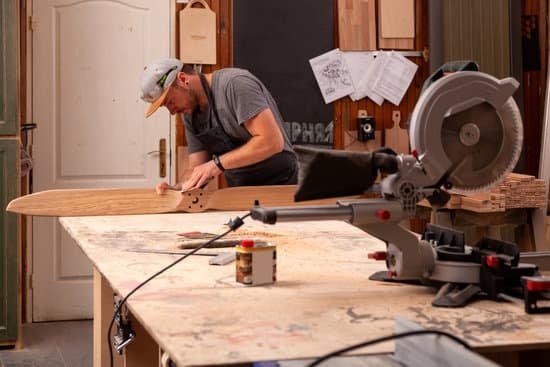Woodworking vises are essential tools for any woodworking enthusiast, allowing for secure clamping and holding of workpieces during various woodworking tasks. Whether you’re a beginner or an experienced woodworker, knowing how to install a woodworking vise is crucial for enhancing the efficiency and precision of your projects. In this guide, we will explore the process of installing a woodworking vise, from choosing the right type to adjusting and testing its functionality.
A woodworking vise serves as an invaluable tool in a woodworker’s arsenal, providing stability and support for a wide range of cutting, drilling, sanding, and assembly tasks. With the ability to firmly grip workpieces at different angles, these vises enable woodworkers to work with greater accuracy and control. In this introductory section, we will delve into the significance of a woodworking vise and its various uses in woodworking projects.
Whether you’re looking to hold pieces securely during hand sawing or chiseling, or need a reliable clamping system for intricate joinery work, understanding how to install a woodworking vise is key to achieving professional results in your woodworking endeavors. Additionally, we will also cover maintenance and care practices to ensure your vise’s longevity and provide additional tips and tricks for effective usage across different projects.
So let’s get started on understanding the importance of a woodworking vise and learning how to install one for your own workshop needs.
Choosing the Right Woodworking Vise
When it comes to choosing the right woodworking vise for your projects, it’s important to consider the different types available and their features and benefits. Each type of vise has its own advantages and is designed for specific woodworking tasks. Understanding the differences between them will help you make an informed decision when selecting a woodworking vise for your workshop.
Types of Woodworking Vises
There are several types of woodworking vises to choose from, including bench vises, front vises, end vises, shoulder vises, and tail vises. Bench vises are the most common type and are typically mounted on the front of a workbench.
Front vises, on the other hand, are mounted on the front edge of the workbench and are ideal for holding boards in place while planing or sanding. End vises are located at the end of the workbench and provide support for longer boards or panels.
Understanding Their Features and Benefits
Each type of woodworking vise comes with its own set of features that cater to specific woodworking needs. For example, a shoulder vise is designed for holding narrow stock on its edge for joinery work, while a tail vise provides support at the opposite end of the workbench.
When choosing a woodworking vise, consider factors such as jaw width, jaw opening capacity, clamping force, and overall durability. Additionally, some woodworking vises may have built-in quick release mechanisms or other convenient features that enhance ease of use.
Factors to Consider
When exploring different types of woodworking vises available on the market, consider factors such as your typical project sizes and types, frequency of use, budget constraints, and available space in your workshop. By understanding the features and benefits of each type of woodworking vise in relation to your specific needs and preferences, you can select the right one that will serve you well in your woodworking endeavors.
Gathering the Necessary Tools and Materials
Before you start the installation process of a woodworking vise, it’s essential to gather all the necessary tools and materials needed for the job. The following list outlines the items required for installing a woodworking vise:
1. Woodworking Vise: Of course, you’ll need the actual woodworking vise that you plan to install. There are various types available, including bench vises, front vises, and tail vises. Be sure to choose one that best suits your specific woodworking needs.
2. Workbench: You’ll need a sturdy workbench with a thick top that can support the weight of the vise and withstand the clamping pressure during use.
3. Drill and Drill Bits: A power drill and appropriate drill bits will be necessary for creating holes in the workbench for mounting the vise.
4. Wrench or Socket Set: To tighten nuts and bolts during the installation process, you’ll need a wrench or socket set in various sizes.
5. Wood Screws or Bolts: Depending on the type of woodworking vise and workbench material, you’ll require wood screws or bolts for securing the vise to the workbench.
6. Safety Gear: Safety goggles are essential to protect your eyes during drilling and other tasks involving potential flying debris. Additionally, gloves may be useful when handling sharp objects or heavy equipment.
By ensuring that you have all of these tools and materials on hand before starting the installation process, you can streamline the project and avoid interruptions due to missing items. Now that you have everything prepared, it’s time to move on to preparing the workbench for installing your woodworking vise.
Preparing the Workbench
When it comes to installing a woodworking vise, one of the crucial steps is preparing the workbench for the installation process. Properly preparing the workbench ensures that the vise is securely mounted and functions effectively during woodworking projects. In this section, we will provide step-by-step instructions on how to prepare your workbench for the woodworking vise installation.
Gathering Necessary Tools and Materials
Before you begin preparing your workbench for the woodworking vise installation, it is important to gather all the necessary tools and materials. This includes a drill with appropriate drill bits, screws or bolts for mounting the vise, measuring tape, pencil for marking, and safety gear such as gloves and eye protection. It’s essential to have all these items on hand before starting the preparation process.
Cleaning and Clearing the Workbench
The first step in preparing the workbench is to ensure that it is clean and clear of any obstructions. Remove any existing clutter or debris from the work surface so that you have ample space to work with. Additionally, make sure that there are no protruding nails or screws that could interfere with the installation of the vise. A clean and clear workbench will make it easier to position and mount the woodworking vise.
Marking Mounting Holes
Once the workbench is cleaned and cleared, carefully measure and mark the placement of the mounting holes for the woodworking vise. Use a measuring tape to determine precise measurements for where you want to install the vise on your workbench. Mark these positions with a pencil or marker, ensuring that they are accurately aligned according to your needs and preferences.
By following these step-by-step instructions, you can effectively prepare your workbench for installing a woodworking vise. Taking care in this preparation process will ensure that your vise is securely mounted and ready for use in various woodworking projects.
Installing the Woodworking Vise
Installing a woodworking vise is an essential step in setting up a functional and efficient woodworking space. Before beginning the installation process, it’s important to choose the right type of vise for your specific needs, whether it be a front vise, tail vise, or shoulder vise. Once you have selected the appropriate vise for your workbench, it’s time to gather the necessary tools and materials for the installation process.
To install a woodworking vise, you will need a variety of tools and materials, including a drill, screws or bolts, wood glue, clamps, and possibly additional hardware depending on the type of vise you have chosen. It’s also crucial to ensure that you have the appropriate safety gear on hand, such as safety goggles and gloves, to protect yourself during the installation process.
Once you have gathered all the necessary tools and materials, the next step is to prepare your workbench for the installation of the woodworking vise. This may involve marking out where the vise will be mounted on the workbench and making any necessary modifications to ensure a secure fit. With proper preparation and attention to detail, you can ensure that your woodworking vise is installed correctly and securely, providing you with a reliable tool for your future woodworking projects.
Adjusting and Testing the Vise
Installing a woodworking vise is an essential step in setting up a functional and efficient woodworking workspace. Once the vise is securely mounted to the workbench, it’s crucial to adjust it properly to ensure smooth operation. In this section, we’ll discuss how to make the necessary adjustments and properly test the functionality of your woodworking vise.
To adjust the woodworking vise, start by loosening the mounting hardware that secures the vise to the workbench. This will allow you to move the vise along the bench and position it according to your specific needs. Make sure that the vise is aligned parallel to the edge of the workbench for optimal performance.
Next, check that the wooden jaws of the vise are properly aligned and planed. If they are not level or smooth, use a hand plane or sandpaper to make any necessary adjustments. This will ensure that your vise can securely grip and hold wooden pieces during your woodworking projects.
After making these initial adjustments, tighten the mounting hardware of the vise back onto the workbench. Use a wrench or screwdriver as needed to ensure that it is securely fastened in place. Once this is done, test the functionality of your woodworking vise by placing a scrap piece of wood between the jaws and tightening them securely. Try different clamping positions and pressures to ensure that everything operates smoothly without any unexpected movement.
| Adjusting Steps | Testing Functionality |
|---|---|
| Loosen mounting hardware | Place scrap wood between jaws |
| Align and plane wooden jaws | |
| Tighten mounting hardware |
Properly adjusting and testing your woodworking vise is crucial for ensuring that it functions smoothly and efficiently. Taking the time to make these adjustments will result in a reliable tool for securing your workpieces during various woodworking tasks. With a well-adjusted vise, you can have confidence in its ability to hold your projects firmly in place while you work on them.
Maintenance and Care
Once you have successfully installed your woodworking vise, it is important to ensure that you maintain and care for it properly in order to prolong its lifespan and guarantee optimal performance. Proper maintenance will also prevent any potential issues that may arise from neglect or wear and tear. Here are some best practices for maintaining and caring for your woodworking vise:
- Regular cleaning: Keeping your woodworking vise clean is essential to prevent the buildup of sawdust, dirt, or debris that can affect its functionality. Use a soft brush or compressed air to remove any accumulation of dust or particles.
- Lubrication: Applying lubricant to the moving parts of the vise will help keep it operating smoothly. Be sure to use a lubricant that is suitable for woodworking tools and follow the manufacturer’s recommendations.
- Inspection: Periodically inspect all components of the vise for any signs of wear, damage, or looseness. This includes the screws, jaws, handle, and any other moving parts. Tighten any loose components and replace any worn-out parts as needed.
In addition to these maintenance practices, it is also important to properly store your woodworking vise when not in use. If possible, cover it with a cloth or protective cover to shield it from dust and moisture. Avoid exposing it to extreme temperatures or harsh environmental conditions.
By following these maintenance and care practices, you can prolong the lifespan of your woodworking vise and ensure that it continues to perform at its best for years to come. Taking care of your tools is essential in maintaining their quality and efficiency in woodworking projects.
Additional Tips and Tricks
In conclusion, installing a woodworking vise is an essential skill for any woodworker, as it allows for secure clamping and holding of workpieces during various woodworking projects. By following the steps outlined in this guide, you can ensure that your woodworking vise is properly installed and functioning optimally.
Once the woodworking vise is successfully installed, it’s important to take some time to familiarize yourself with its features and functionality. This includes adjusting the vise to suit your specific needs and testing its operation to ensure smooth and reliable performance. Additionally, proper maintenance and care of the vise will help prolong its lifespan and keep it in top working condition.
Moreover, these additional tips and tricks provided in this section will further enhance your woodworking experience with the vise. Understanding how to effectively use the vise in different woodworking projects, as well as troubleshooting common issues that may arise, will give you the confidence to tackle a wide range of tasks with ease. Overall, mastering the installation and use of a woodworking vise is a valuable skill that will greatly benefit any woodworker.

Hi everyone! I’m a woodworker and blogger, and this is my woodworking blog. In my blog, I share tips and tricks for woodworkers of all skill levels, as well as project ideas that you can try yourself.





